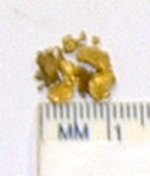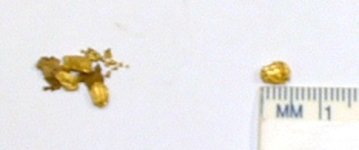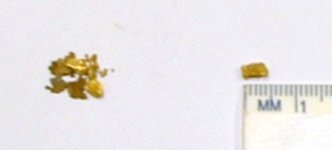with great anticipation of small gold being found on totlots, as well as many coins! here is a short test KT did with some small gold nuggets He has and compared to his BH Tracker IV (which by the way is not a gold nugget hunter!...if you want a Gold Nugget hunter then buy a Gold Bug!  )
)
But anyway, The King wanted to run this test. He has a small vial with small gold nuggets...The nuggets are shown in the first pic. The largest nugget is shown in pic 2, the 2nd largest in pic 3.
Ok, here was the test...first put the nuggets into a plastic container. Check the ground with the Tesoro for signals in all metal mode....ok no signals. Place container on ground and check with Tesoro. Good signal for group of nuggets at 3 inches. Now place largest nugget, pic 2, in separate plastic container and pass the Compadre coil over it again. Signal at 1.5 inches. Now replace with 2nd largest nugget...pic 3 and run coil over it...signal at 0.5 inch, nothing at .75 inch.
The same initial test with the BH Tracker IV gave no signal on the cluster of nuggets at any distance.
So, KT's conclusion is Yes, the Compadre is more sensitive to small gold than the Tracker IV in the all metal mode.
However, KT does not run the Compadre in the all metal mode but up in the iron range...unless the site is absolutely not trashy.
KT does feel the machine has been fairly represented by the other members of the C of the C, but still has not recovered a small piece of real gold to absolutely prove it will find small gold, like an earring backing, or a single gold link from a chain. That is the real world test. The nice thing is that in the real world KT already recovered a nice 5 gram gold ring at 8 inches in mulch with the Compadre, so He knows He can find some decent gold!
Onward to real world testing in 2012!!!!!!!!!! Happy New Year to all!
 )
)But anyway, The King wanted to run this test. He has a small vial with small gold nuggets...The nuggets are shown in the first pic. The largest nugget is shown in pic 2, the 2nd largest in pic 3.
Ok, here was the test...first put the nuggets into a plastic container. Check the ground with the Tesoro for signals in all metal mode....ok no signals. Place container on ground and check with Tesoro. Good signal for group of nuggets at 3 inches. Now place largest nugget, pic 2, in separate plastic container and pass the Compadre coil over it again. Signal at 1.5 inches. Now replace with 2nd largest nugget...pic 3 and run coil over it...signal at 0.5 inch, nothing at .75 inch.
The same initial test with the BH Tracker IV gave no signal on the cluster of nuggets at any distance.
So, KT's conclusion is Yes, the Compadre is more sensitive to small gold than the Tracker IV in the all metal mode.
However, KT does not run the Compadre in the all metal mode but up in the iron range...unless the site is absolutely not trashy.
KT does feel the machine has been fairly represented by the other members of the C of the C, but still has not recovered a small piece of real gold to absolutely prove it will find small gold, like an earring backing, or a single gold link from a chain. That is the real world test. The nice thing is that in the real world KT already recovered a nice 5 gram gold ring at 8 inches in mulch with the Compadre, so He knows He can find some decent gold!
Onward to real world testing in 2012!!!!!!!!!! Happy New Year to all!







 I did find a setting just before the "iron" where I can blip on some nails and found a socket from a ratchet set.
I did find a setting just before the "iron" where I can blip on some nails and found a socket from a ratchet set.